Myogenin recruits the histone chaperone facilitates chromatin transcription (FACT) to promote nucleosome disassembly at muscle-specific genes
- PMID: 23364797
- PMCID: PMC3597808
- DOI: 10.1074/jbc.M112.426718
Myogenin recruits the histone chaperone facilitates chromatin transcription (FACT) to promote nucleosome disassembly at muscle-specific genes
Abstract
Facilitates chromatin transcription (FACT) functions to reorganize nucleosomes by acting as a histone chaperone that destabilizes and restores nucleosomal structure. The FACT complex is composed of two subunits: SSRP1 and SPT16. We have discovered that myogenin interacts with the FACT complex. Transfection of FACT subunits with myogenin is highly stimulatory for endogenous muscle gene expression in 10T1/2 cells. We have also found that FACT subunits do not associate with differentiation-specific genes while C2C12 cells are proliferating but are recruited to muscle-specific genes as differentiation initiates and then dissociate as differentiation proceeds. The recruitment is dependent on myogenin, as knockdowns of myogenin show no recruitment of the FACT complex. These data suggest that FACT is involved in the early steps of gene activation through its histone chaperone activities that serve to open the chromatin structure and facilitate transcription. Consistent with this hypothesis, we find that nucleosomes are depleted at muscle-specific promoters upon differentiation and that this activity is dependent on the presence of FACT. Our results show that the FACT complex promotes myogenin-dependent transcription and suggest that FACT plays an important role in the establishment of the appropriate transcription profile in a differentiated muscle cell.
Figures
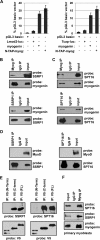
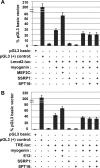

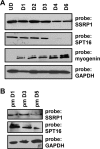

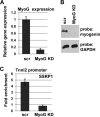
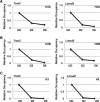


Similar articles
-
Effects of myogenin on expression of late muscle genes through MyoD-dependent chromatin remodeling ability of myogenin.Mol Cells. 2012 Aug;34(2):133-42. doi: 10.1007/s10059-012-2286-1. Epub 2012 Jul 18. Mol Cells. 2012. PMID: 22814845 Free PMC article.
-
MyoD targets chromatin remodeling complexes to the myogenin locus prior to forming a stable DNA-bound complex.Mol Cell Biol. 2005 May;25(10):3997-4009. doi: 10.1128/MCB.25.10.3997-4009.2005. Mol Cell Biol. 2005. PMID: 15870273 Free PMC article.
-
FACT, the Bur kinase pathway, and the histone co-repressor HirC have overlapping nucleosome-related roles in yeast transcription elongation.PLoS One. 2011;6(10):e25644. doi: 10.1371/journal.pone.0025644. Epub 2011 Oct 12. PLoS One. 2011. PMID: 22022426 Free PMC article.
-
[Structure and function of histone chaperone FACT].Mol Biol (Mosk). 2015 Nov-Dec;49(6):891-904. doi: 10.7868/S0026898415060026. Mol Biol (Mosk). 2015. PMID: 26710768 Review. Russian.
-
The histone chaperone FACT: structural insights and mechanisms for nucleosome reorganization.J Biol Chem. 2011 May 27;286(21):18369-74. doi: 10.1074/jbc.R110.180778. Epub 2011 Mar 24. J Biol Chem. 2011. PMID: 21454601 Free PMC article. Review.
Cited by
-
SSRP1 promotes colorectal cancer progression and is negatively regulated by miR-28-5p.J Cell Mol Med. 2019 May;23(5):3118-3129. doi: 10.1111/jcmm.14134. Epub 2019 Feb 14. J Cell Mol Med. 2019. Retraction in: J Cell Mol Med. 2024 Sep;28(17):e70048. doi: 10.1111/jcmm.70048. PMID: 30762286 Free PMC article. Retracted.
-
Proteasomal Regulation of Mammalian SPT16 in Controlling Transcription.Mol Cell Biol. 2021 Mar 24;41(4):e00452-20. doi: 10.1128/MCB.00452-20. Print 2021 Mar 24. Mol Cell Biol. 2021. PMID: 33526453 Free PMC article.
-
Nucleolin mediates nucleosome disruption critical for DNA double-strand break repair.Proc Natl Acad Sci U S A. 2013 Oct 15;110(42):16874-9. doi: 10.1073/pnas.1306160110. Epub 2013 Sep 30. Proc Natl Acad Sci U S A. 2013. PMID: 24082117 Free PMC article.
-
Pluripotency transcription factor Oct4 mediates stepwise nucleosome demethylation and depletion.Mol Cell Biol. 2015 Mar;35(6):1014-25. doi: 10.1128/MCB.01105-14. Epub 2015 Jan 12. Mol Cell Biol. 2015. PMID: 25582194 Free PMC article.
-
A topographic atlas defines developmental origins of cell heterogeneity in the human embryonic lung.Nat Cell Biol. 2023 Feb;25(2):351-365. doi: 10.1038/s41556-022-01064-x. Epub 2023 Jan 16. Nat Cell Biol. 2023. PMID: 36646791 Free PMC article.
References
-
- Berkes C. A., Tapscott S. J. (2005) MyoD and the transcriptional control of myogenesis. Semin. Cell Dev. Biol. 16, 585–595 - PubMed
-
- Molkentin J. D., Black B. L., Martin J. F., Olson E. N. (1995) Cooperative activation of muscle gene expression by MEF2 and myogenic bHLH proteins. Cell 83, 1125–1136 - PubMed
-
- Wang D. Z., Valdez M. R., McAnally J., Richardson J., Olson E. N. (2001) The Mef2c gene is a direct transcriptional target of myogenic bHLH and MEF2 proteins during skeletal muscle development. Development 128, 4623–4633 - PubMed
-
- Rudnicki M. A., Schnegelsberg P. N., Stead R. H., Braun T., Arnold H. H., Jaenisch R. (1993) MyoD or Myf-5 is required for the formation of skeletal muscle. Cell 75, 1351–1359 - PubMed
Publication types
MeSH terms
Substances
Grants and funding
LinkOut - more resources
Full Text Sources
Other Literature Sources
Molecular Biology Databases
Research Materials
Miscellaneous

